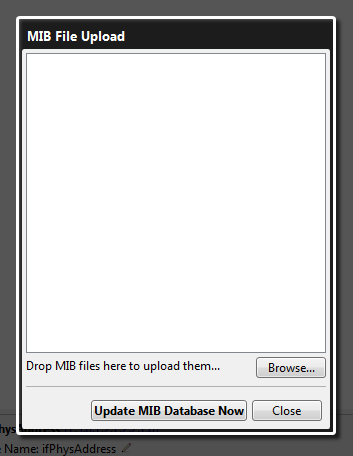vSNMP - Managing MIB Files
MIB Browsing
- vSNMP contains a standard MIB library of about 300 MIB modules. Most MIB modules that are publicly available as RFCs are included.
- This standard library makes it possible to get a lot of network-related information out of any SNMP device (like number of NICs, IP addresses, routing tables etc.)
You can browse the MIB library in the MIB Tree tab. Most standard network management objects can be found underiso.org.dod.internet.mgmt.mib-2. - To navigate to a specific object, you can use the address bar found above the MIB tree:

- Example: to navigate to the columnar object ifDescr defined in IF-MIB, you can either type the object’s OID (1.3.6.1.2.1.2.2.1.2) or
IF-MIB::ifDescrinto the address bar, then press enter. - Under MIB View on the right pane you can examine information about the selected MIB object:

MIB Querying
- Using the address bar, you can also issue queries against the MIB database. The simplest query would be to just enter the name of the object you want to find. This will bring up the query results tab:

- Note that vSnmp will run the query against all child objects of the currently selected object. So if you want to query the entire MIB database, either switch to the MIB Query tab to enter your query or select the “iso” node in the MIB Tree tab before entering the query.
- You can also issue queries that are much more complex. The syntax of the query language is based on the syntax used by Windows Explorer’s search feature (e.g.
name:*.png size:large). - Likewise, you can query properties of objects in vSNMP: The query string
name=if* basetype=integerwould yield all objects whose names start with “if” and whose syntax can be resolved to INTEGER.
The query string (type=agent-capabilities or type=module-compliance)module:ciscowould yield all AGENT-CAPABILITIES and MODULE-COMPLIANCE nodes that are defined in a module whose name contains the string “cisco”. - An application note covering the full syntax of the query language is pending.
MIB File Upload
- To access custom functionality offered by a device, you need to upload some device-specific MIB files published by the device’s manufacturer.
- To do so, switch to the MIB Modules tab on the left pane:

- Click the
 button to upload MIB files. This will bring up the upload dialog:
button to upload MIB files. This will bring up the upload dialog:
- Click the Browse button and navigate to the folder where your MIB files are stored. Then select all the MIB files you want to upload.
- Alternatively, you can drag MIB files from Windows Explorer and drop them on the upload dialog.
- As soon as all uploads are marked “Complete”, click the Update MIB Database Now button to re-compile the MIB database. The compilation process will take some time and when it has finished, the vSnmp.Editor will need to re-initialize. Therefore, you will be asked to save any unsaved device classes before the MIB database is rebuilt.
- After the compilation process has finished, keep an eye on the notification area in the top left corner of the vSnmp.Editor main window. If it displays a red border, the MIB compiler has encountered errors in the MIB files you have uploaded:

- Open the notification area’s drop down window and examine the reported errors. If a “missing module” is reported, you also need to upload the MIB files reported missing.
- Even when encountering errors in a MIB file, vSnmp will load as many objects from the file as possible. The objects which failed to load are reported in the notification area.
Navigation
vSNMP - Connecting to a Device